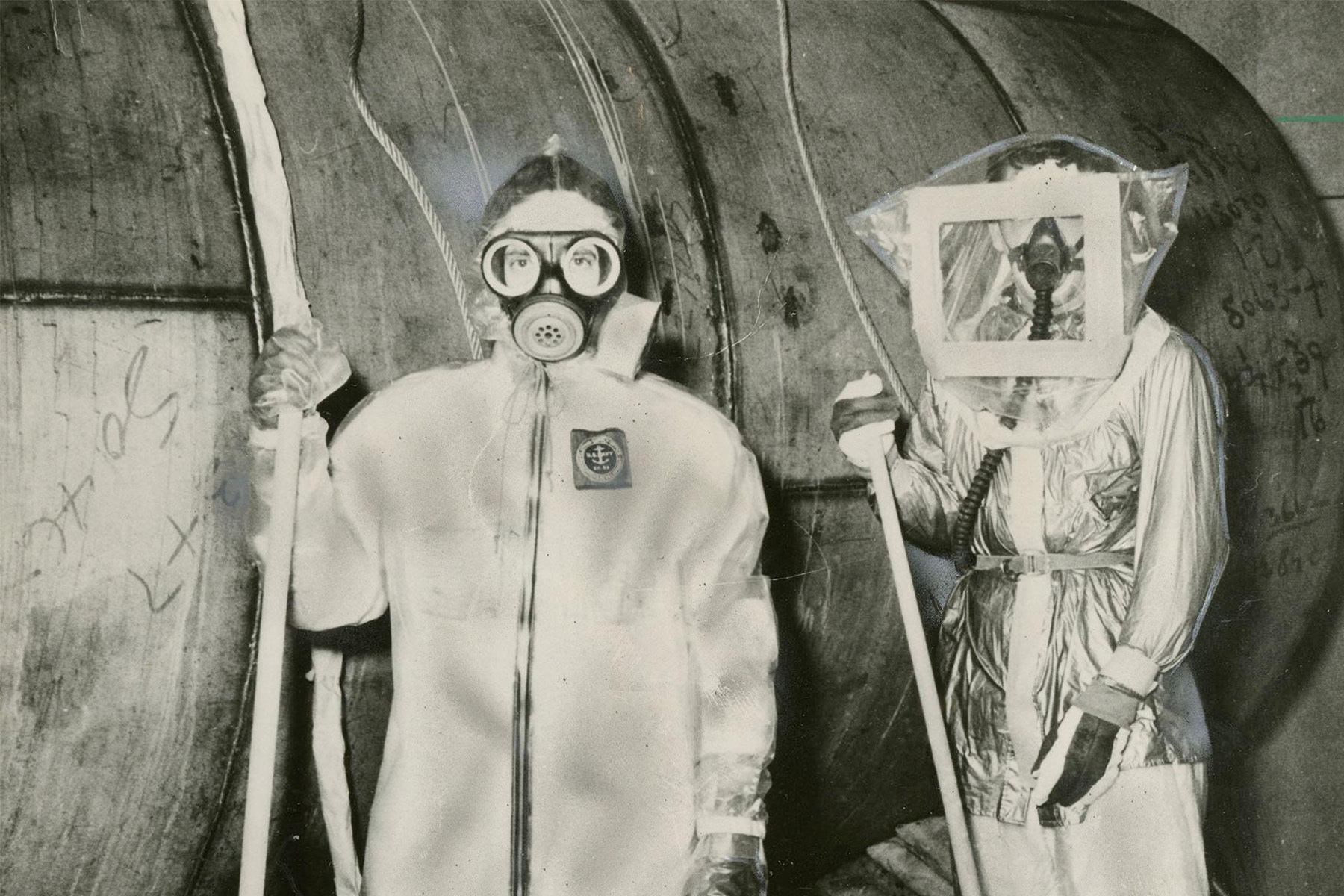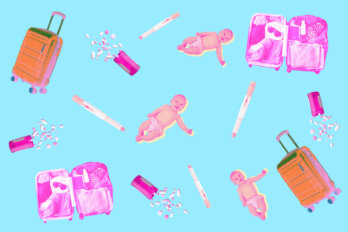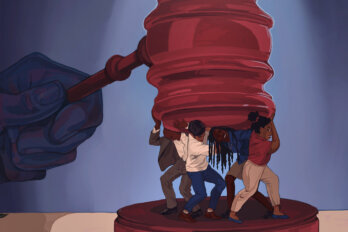
This story was originally published as “Les accidents nucléaires oubliés de Chalk River” by our friends at Québec Science on October 7, 2021. It has been reprinted here with permission.
The world’s first serious nuclear accident occurred in Ontario in 1952, followed by a second incident there in 1958. A look back at these events now that the federal government is compensating workers who took part in cleanup efforts.
George Kiely is at a loss for words. On a July morning in 2021, I phone to get his reaction to the federal budget tabled three months earlier. One measure had caught my eye: $22.3 million set aside for several hundred workers who cleaned up Chalk River Laboratories after two nuclear accidents in the 1950s. I hadn’t known about these incidents.
Kiely knows them all too well. He and other retired employees of Atomic Energy of Canada Limited (AECL), a Crown corporation, had fought for thirteen years for some form of recognition for the risks they faced during the accidents. Before my call, he hadn’t heard that their efforts had paid off. I am as puzzled as he is.
After a long pause, he mentions his friend and former coworker Al Donohue, who is ninety-two. “I hope we live long enough to get the reward,” says Kiely, who is eighty-nine.
HISTORY
This story begins at the Université de Montréal. During the Second World War, the university housed a secret laboratory set up through an alliance between Canada, Britain, and the United States. Several hundred researchers and technicians conducted nuclear research there.
“The Montreal Laboratory had two goals: build reactors to supply electricity and produce plutonium to eventually make a bomb,” says Gilles Sabourin, author of Montreal and the Bomb, published in English in 2021. “The lab carried out experiments and worked on the design of the NRX [National Research Experimental] reactor and a plutonium-extraction plant.” The plan was to build the facilities in Chalk River, 180 kilometres north of Ottawa.
Then, in 1945, the world’s first atomic bomb was tested in New Mexico. Two others were dropped on Japan a few weeks later, bringing the war to an end.
One month after the bombings, Chalk River Laboratories (which was actually located in Deep River) opened. The public was told that the labs would be doing peaceful nuclear research. Still, military objectives remained: Canada supplied the United States with uranium for military purposes for two decades after the war, along with 252 kilograms of plutonium between 1959 and 1964.
NRX became operational in 1947. With a twenty-megawatt capacity, it was then “the world’s most powerful and best reactor for doing experiments,” says James Ungrin, who worked for its accelerator physics branch. Ungrin gives me a tour of the museum set up by the Society for the Preservation of Canada’s Nuclear Heritage in Deep River. The museum is packed with intriguing artifacts, including red underwear worn by workers in “active” zones, the colour a reminder to change their shorts before they went home.
“All of a sudden, AECL and Chalk River had a phenomenal profile worldwide,” Ungrin tells me. “There were experiments done here that couldn’t be done elsewhere. Experts were flocking here.”
The site, known as “the campus,” has been called stunning. “All the descriptions of the place from the 1950s mention how natural and beautiful the landscape is,” says Frances Reilly, a historian interested in the atom’s impact on popular culture in Canada.
I see that beauty for myself when Canadian Nuclear Laboratories (CNL), the private consortium that has managed the site for AECL since 2014, opens its doors to me. After a security check at the entrance to the 4,000-hectare grounds, I drive a few kilometres on a winding road lined with trees and marshes. I arrive at a group of buildings set against the backdrop of the Ottawa River and the mountains of Quebec.
The NRX building is made of red brick and has windows several storeys high. It is truly striking, a design rarely seen anymore, since such facilities are now constructed out of concrete for safety reasons.
At the centre of the light-filled plant stands the reactor. It is housed in a concrete enclosure with catwalks, rails, and a crane overhead. At one time, the plant was state of the art, complete with automated and remote-control systems. “Machines would move around on top of the reactor to change the fuel and do other tasks,” Sabourin says. “It was all very sci-fi.”
The reactor vessel, called the calandria, contained 175 long rods inserted vertically. Of these, 163 were filled with uranium fuel and the remaining twelve with boron carbide, which can absorb neutrons and stop the fission chain reaction. If any seven of these twelve control rods were lowered into the reactor, no fission could occur; conversely, control rods needed to be raised to start the reactor. Reactivity could also be controlled by adjusting the level of heavy water in the core. Heavy water resembles ordinary water in almost every way, but its hydrogen atoms are heavier isotopes. Its presence in the reactor slowed down neutrons to make them more effective for fission.
Draining the heavy water could halt the chain reaction. Finally, ordinary water circulated around the fuel rods to keep everything at an acceptable temperature.
In the plant’s first year of operation, the National Film Board of Canada shot a short documentary on site as part of its Eye Witness series. In the film, the narrator states that safety was a serious concern here. “Radioactive contamination is silent and deadly,” he says. “A special health crew checks workers constantly. Each worker checks himself before leaving the plant.” He adds that even the paint on the walls was stripped every few months.
In the plant’s control room, there were four important push buttons, as James Mahaffey explains in his 2014 book, Atomic Accidents: A History of Nuclear Meltdowns and Disasters.
- Button one raised a bank of four control rods out of the reactor.
- Button two raised the remaining eight control rods.
- Button three increased the current in the electromagnets to hold the rods in place.
- Button four drove the twelve rods into the reactor using a compressed-air system. If this system failed, gravity alone could draw the rods down.
It was a mix-up involving these buttons that triggered Chalk River’s “Black Friday.”
1952 NUCLEAR ACCIDENT
On Friday, December 12, 1952, at around 3 p.m., the last experiment of the day was about to begin. For the test, the reactor’s cooling system was modified and its water flow reduced, adjustments not seen as worrisome because only very low power would be needed.
An operator was down in the basement doing a routine check. He mistakenly thought the valves for the compressed-air system were in the wrong position. He “corrected” them, causing four control rods to rise out of the core. Red lights came on in the control room. A supervisor hurried downstairs and was shocked to discover the error. He quickly tried to lower the rods using gravity. Unfortunately, only one rod went all the way back into the reactor, while the others dropped down just far enough for the red lights to go out.
To get all the rods back into the reactor, the supervisor phoned his assistant and told him to press buttons one and four. His assistant put down the phone to carry out the instructions, so he didn’t hear his boss shout that he had meant to say buttons three and four. Four additional control rods rose out of the reactor, for a total of seven rods out of twelve. Power in the reactor was now doubling every two seconds.
The red lights came back on. The assistant tried lowering the bank of four rods, but only one dropped back into the reactor, and even that took ninety seconds. In the control room, panic had set in. “There wouldn’t have been a problem if the cooling system hadn’t been altered for the test that day,” Sabourin says.
Th cooling water began to boil instead of circulating to carry heat out of the reactor. The instrument measuring the temperature could no longer keep up with the surge. The rods of uranium melted, contaminating the cooling water.
Designed to handle up to thirty megawatts of power, the reactor rose to between sixty and 100 megawatts. Employees then dumped the heavy water into a tank and successfully stopped the fission. Full loss of control had lasted only sixty-two seconds.
Yet more troubles lay ahead. The supervisor down in the basement heard the sound of air-activated pistons, followed by a dull thud, according to Nucleus: The History of Atomic Energy Canada Limited. The noise was, in fact, an explosion that resulted when hydrogen forming in the reactor from the melting uranium came into contact with air entering the reactor. The cooling water now poured out of the damaged device.
The accident was over, but radiation was spreading. In all, 4.5 million litres of water ended up pooling in the basement. The water was seven times more radioactive than the total world production of radium at the time, according to Canada’s Nuclear Story, a book commissioned by AECL in the 1960s and written by journalist Wilfrid Eggleston.
Dumping this water into the river was therefore out of the question.
The air was also contaminated. Alarms went off in the building and the surrounding area. Donohue was working nearby as the foreman of the crew building the foundations of a new reactor. Once the sirens sounded, he knew the situation was serious. “When they offered me the job, I had to learn a bit about where the hell we were working,” he says. “So I knew radiation was likely airborne. That’s why I got my guys out of there. We just sat in the bus outside the boundary of the plant.”
The accident was the world’s first meltdown of a reactor core. “It was a pretty major event,” Sabourin says. “There’s an international scale for measuring nuclear accidents according to severity, much like for earthquakes. The scale goes from one to seven. The worst accident ever recorded is Chornobyl, which is a seven. Chalk River, since there was a core meltdown, is a five.”
The event was a setback for AECL, and some worried it would spell the end for NRX. “They said, ‘Are we ever going to recover from this?’ because no one had ever seen an accident like this before,” Ungrin says.
It took fourteen months to clean up the site and put the reactor back in service. A pipeline was built to drain the water into a sandy area to filter it before it reached the river. The reactor core was also buried in a sandy spot, which was “a rather rudimentary solution,” says Mahdi Khelfaoui, a professor at the Université du Québec à Trois-Rivières and an expert on Canada’s nuclear history. To avoid overexposure to radiation, men apparently took turns driving the truck that carried the core, which was so contaminated that a person a metre away could absorb a lethal dose in less than an hour.
About 800 AECL employees, along with Canadian and US military personnel, assisted in the cleanup. “The Americans were beginning to make nuclear-powered submarines, and the reactor fuel was being tested at Chalk River,” Ungrin says. “So the interest for the Americans was to try to get NRX back online as soon as they could.”
The public also needed reassuring, because rumours had begun to spread. For example, in Pembroke, fifty kilometres away, there was talk of a policeman finding the buttons of his coat tarnished from radiation. “This was AECL’s first major public outreach effort,” Khelfaoui says. “[The Crown corporation] had only just hired its first public relations officer.”
Two Ottawa Citizen journalists toured the site two days after the accident and wrote a report that downplayed the events. An official told them that the health of workers had never been in danger and that the fear instead was that the radiation would harm the equipment. The headline claimed that damage was “negligible.” “We were then taken to look at the NRX pile building were the ‘leak’ occurred,” they wrote. “It was becoming more and more evident by the minute that stories of dangerous radiation were fantastically exaggerated. . . . We could not have been closer, yet we were in considerably less danger than a man crossing an Ottawa street.” The condition of the reactor was still unknown at the time, leading to some overly optimistic statements to the press, according to an AECL scientific paper from 1980.
The accident was a learning experience for Chalk River Laboratories. “Exactly what happened, how it could happen in spite of all the care taken on the control and shut-down apparatus, what the effects were, how to repair the damage, and how to ensure that such an accident could never occur again were all the subject of intense and prolonged examination in the period which extended between Black Friday and the date fourteen months later when NRX was started up again,” Eggleston wrote.
In the decades since then, AECL has studied radioactive waste storage extensively and refined its approach, particularly given the improvising that went on back in 1952. In 2005, specialists examined the site where the melted fuel rods had been buried in wooden boxes. They found that the boxes had degraded over time and the rods were in direct contact with the soil. Also, according to an AECL conference paper, thirty-two pieces of rod were recovered, more than the nineteen pieces listed in the records. They were all moved to a more suitable storage area in 2007.
After it was back in service, NRX had a long life, shutting down for good only in 1993.
1958 NUCLEAR ACCIDENT
A more powerful reactor, called NRU (National Research Universal), was constructed in a building next to NRX and began operating in 1957 with a capacity of 200 megawatts.
On May 24, 1958, the reactor was shut down so damaged fuel rods could be extracted using a crane and water-cooled fuel flasks and then placed in a storage pool. Mahaffey recounts in Atomic Accidents that when workers removed the second rod, they noted that its fuel flask no longer contained any water.
The crane operator tried reinserting the rod into the reactor, but it got jammed and wouldn’t go all the way in. Crew members in rubber suits and respirators sprayed it with water, with little success. The crane tried to pull the rod back out, but the rod snapped and caught fire. While the crane was moving part of the rod toward the pool, a piece of uranium ninety centimetres long came loose and fell into the repair pit.
“The [radio]activity from the burning active uranium was carried by the fumes in the form of dust, contaminating the whole reactor room and other parts of the NRU building. Since the activity was very high, personnel were evacuated. No one could remain in the area for more than a brief period—two minutes,” wrote David A. Keys, the general manager of the Chalk River facility, in a report cited by Eggleston. Employees, including an accountant, took turns pouring buckets of sand onto the burning metal from a catwalk. Within fifteen minutes, the fire was out.
For this second incident, Donohue had a front-row seat, as he worked for the NRU operations team. He carried bins of sand to an elevator in the aftermath of the accident. “We knew our lives were at risk. Every shift was torture,” he recalls, seated in his lovely Pembroke, Ontario home beside his friend George Kiely. Donohue says that he and his coworkers quickly exceeded the radiation limit deemed acceptable. He was later tasked with preparing volunteers to go into the plant and decontaminate it.
Kiely remembers being suited up by Donohue’s crew. He normally worked in the metallurgy building but immediately agreed to help with the cleanup. The supervisors explained his mission to him: enter the pitch-dark plant, find a large vacuum hose, and use it to suck up “fluorescent pellets” on the floor for ten minutes. “It was one thing when they explained it but another to do it,” Kiely says. “I went in and found the vacuum hose, which was about eight feet long. It had an elbow on the end, which kept sliding sideways because they’d put it on with duct tape. By the time I figured out what I was doing, I had to get out. I must have vacuumed an area of only about ten square feet.” Once again, over 800 AECL employees, as well as 300 military personnel, took part in the operation.
The 1958 accident was less serious than the previous one. It was never classified, but it would potentially be a level four or five. The reactor was shut down for only six months. It, too, had a long career, becoming a major source of medical isotopes for the entire planet for decades. It finally ceased operations in 2018.
Given the events of 1952 and 1958, an extra security measure was added when it came time to design the famous CANDU reactors that generate electricity. “In Canada, besides control rods that drop down by gravity or with a spring, there is another completely independent system,” Sabourin says. “It injects a poison, gadolinium, to absorb neutrons.”
Rosaura Ham-Su, who heads up the advanced reactors directorate at CNL, says that NRX and NRU were used to simulate all kinds of catastrophic situations in the decades following the accidents. “Both NRX and NRU were meant to test the fuel. When you test the fuel, you bring [the reactor] to the temperature that it’s supposed to operate at, and sometimes beyond that [to study the effects],” she says. “NRU, for example, had a place where you could test CANDU fuel in steam conditions. So this was basically pretending that there was an accident and the water had to vaporize, and then what would happen? All those tests were critical to having a very safe reactor to operate.”
Despite their scientific significance, the two accidents have largely been forgotten. It’s a pity, Khelfaoui says. “More attention should have been paid to these incidents and to the workers exposed to doses of radiation during the cleanup.”
AFTERMATH
On the balcony of their home in Hampstead, a town on the Island of Montreal, Gordon and Karen Edwards serve me bottled water. “After all these years of hearing Gordon go on about nuclear risks [like contaminated waterways], I can’t drink water from the river,” Karen says with a laugh.
Gordon Edwards is a co-founder of the Canadian Coalition for Nuclear Responsibility. In 1979, he received a call from a Montreal community group. “They said, ‘We have a military man who’s contacted us about an accident that happened in Chalk River, at a nuclear reactor, back in 1958. Have you ever heard of this? This man has multiple cancers and is trying to get a pension for harm done during his military service.’”
Edwards agreed to help the man, Bjarnie Hannibal Paulson, who had undergone dozens of surgeries to treat basal cell carcinomas in his anal region and on his chest and face. Radioactive particles seemed to have lodged in Paulson’s hair follicles. They weren’t detected on his body after he had passed through the danger zone and showered because they were alpha particles, which are harder to detect than beta or gamma radiation.
Paulson was a corporal posted at the military base in Saint-Jean-sur-Richelieu, Quebec, when he was sent to Chalk River to help with decontamination efforts for two weeks. One of his tasks was to saw the hose off the legendary vacuum cleaner, which needed to be removed and buried.
In 1982, Edwards teamed up with Duncan Thomas, an epidemiology professor at McGill University, to do a study on the health of military personnel involved in the cleanup. According to an article in Le Devoir, Thomas told the Canadian Pension Commission that he had managed to track down sixty-five of the men, fifteen of whom had cancer of some type, four times the normal cancer rate found in the general population.
That same year, the Department of Veteran Affairs asked researchers at the University of Ottawa to study the mortality of military personnel who had assisted with the Chalk River cleanup or taken part in dangerous testing in the desert in the 1950s to train for nuclear war.
In their 1984 report, the researchers pointed out that their study didn’t cover all military personnel involved in the cleanup because a fire in Chalk River Laboratories in the late 1950s had destroyed some documentation listing the participants. The researchers also wrote that they had found no abnormal increase in deaths among the thousand men in the study. (A similar report concerning AECL employees drew the same conclusion in 1986.) They stressed that their findings on mortality couldn’t be extended to morbidity, the incidence of diseases affecting personnel exposed to radiation. “In particular, cancer,” they wrote. They suggested conducting a second study to clarify this point, but it was never carried out.
In the six years following their first meeting, Edwards and Paulson appeared before the Canadian Pension Commission eight times without ever winning their case. The Federal Court of Appeal ordered a review of the matter, and Paulson was finally granted a pension.
As for Donohue and Kiely, they have had no long-term effects that they know of. But Donohue’s voice breaks when he talks about Raymond Paplinskie, a crane operator at NRU. As the result of sinus cancer, Paplinskie underwent several surgeries, which disfigured him. “I saw him at the grocery store one Sunday afternoon, and he turned away and didn’t want to see me. I went to him anyway and said, ‘Ray, I’m with you.’ It was the saddest sight I ever saw.” Paplinskie submitted claims but died without receiving compensation. “Not a cent,” Donohue says.
Donohue and Kiely were shocked to learn, in 2008, that military personnel participating in the Chalk River decontamination efforts in the 1950s could claim compensation, whereas former AECL employees were ineligible. The $24,000 payment was awarded within the Atomic Veterans Recognition Program (which also covered military personnel involved in the desert testing). The aim wasn’t to recognize health repercussions but rather to acknowledge service to the nation. Edwards says the money was “way too little and way too late” and fears that the true effects of the two accidents will never be brought to light.
Afew years later, senator Céline Hervieux-Payette received a letter from former AECL employees, including Donohue and Kiely. “I was in the Senate for twenty-one years and replied to every letter I received,” says the now retired senator as she prepares tea.
This letter was no exception, and Hervieux-Payette decided to help the group. “Don’t forget that I’m a lawyer, and I felt I had a good case,” she says. She met twice with the men, who spoke about their experiences and sense of injustice. “I first prodded the government from the inside but without much success, so I put forward a motion, which easily passed the Senate in 2016.”
Still, the matter languished until the 2021 budget. Former employees, or their descendants, can now claim a nominal sum. Again, is the money too little too late? “I believe it’s never too late to right a wrong,” Hervieux-Payette says.
Natural Resources Canada has stated that in the coming months, it will define the parameters of the new program and contact former employees to ensure they are informed.
Kiely and Donohue say they won’t believe the news until they get the cheque in the mail.
This story was reprinted with permission from Québec Science.




